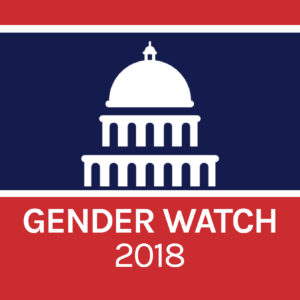New Research Shows Women Candidates’ Motivation to Run Differs by Race and Ethnicity
 From March to December 2018, the Barbara Lee Family Foundation (BLFF) and the Center for American Women and Politics (CAWP) partnered to offer Gender Watch 2018, which tracked, analyzed, and illuminated gender dynamics in the 2018 midterm elections. With the help of expert scholars and practitioners, Gender Watch 2018 furthered public understanding of how gender influences candidate strategy, voter engagement and expectations, media coverage, and electoral outcomes in campaigns. The blog below was written for Gender Watch 2018, as part of our collective effort to raise questions, suggest answers, and complicate popular discussions about gender’s role U.S. elections.
From March to December 2018, the Barbara Lee Family Foundation (BLFF) and the Center for American Women and Politics (CAWP) partnered to offer Gender Watch 2018, which tracked, analyzed, and illuminated gender dynamics in the 2018 midterm elections. With the help of expert scholars and practitioners, Gender Watch 2018 furthered public understanding of how gender influences candidate strategy, voter engagement and expectations, media coverage, and electoral outcomes in campaigns. The blog below was written for Gender Watch 2018, as part of our collective effort to raise questions, suggest answers, and complicate popular discussions about gender’s role U.S. elections.

In their recently published article, “Always Running: Candidate Emergence among Women of Color Over Time,” Drs. Andrea Silva and Carrie Skulley investigate how challenges to and advantages of women candidates differ by candidate race and ethnicity. Their timely research, published in Political Research Quarterly this summer, provides important insights to help put this year’s increase in women’s candidacies into important context.
We interviewed Drs. Silva and Skulley about their research and findings and provide their answers below.
You recently published an article on candidate emergence among women of color over time. What do you mean when you say “candidate emergence” and how did you measure it in your research?
Candidate emergence represents the final step in the process of thinking about running for office. It reflects the decision to contest a seat for an elective office. In our paper, we measure candidate emergence as the percent of women who officially ran in a primary for a House seat in a given election cycle.
If you had to pull out the most notable findings from your project, what would they be?
Our most notable finding is that women of color navigate politics differently than their white counterparts beginning with the initial decision to run for office. Our findings echo those of qualitative studies (e.g., Sisters in the Statehouse by Nadia Brown, and The Latina Advantage by Christina Bejarano) which document the importance of focusing on the intersection of race and gender in politics. Our research also demonstrates that small sample sizes should not be a deterrent in studying these women and their experiences quantitatively.
What motivated you to take on this research? Why, in particular, did you want to look at differences in candidate emergence among women by race and ethnicity?
We always room together at conferences and frequently find ourselves feeling disgruntled about how literatures that should be in conversation with each other frequently are not (we are huge nerds). This frustration led us to thinking about ways we could put the race and ethnic politics literature in better conversation with the women and politics literature.
As we began to think about the shortcomings we saw in those literatures, we quickly identified a gap: we know a fair amount about women candidates and congressional elections in the aggregate and we know a fair amount about candidates of color and congressional elections, but we didn’t know a whole lot about women of color as candidates in congressional elections. Much of the women and politics literature focuses on the experience of white women or says little on the role of race and ethnicity.
Earlier studies suggested that women of color face different electoral landscapes than both white women and men of color based on the combination of their race and gender. Moreover, we thought the candidate emergence literature had some exciting and testable theories about the conditions under which women run, and we wanted to know how these theories performed for women of color. By using a cross sectional time series analysis, we were able to show that disaggregating data by race need not be an insurmountable obstacle to building scholarship about candidate emergence among women of color.
In 2018, there has been much attention to the surge of women making the decision to run for office and everyone has a theory about why women are running this year. Your research seems to say that we should be cautious about assuming that the reasons and conditions for candidacy are universal among women candidates. Is that fair? Are there any other ways in which your findings can help us understand or analyze what is happening this year with women running for office?
There definitely seems to be a lot of narratives about why we’re seeing so many women run this cycle. We do think it’s fair to say that a one-size-fits-all explanation for the surge of women candidates this cycle would be misleading. An important takeaway from our research is that what is motivating for one group may not be equally motivating for another. This may be particularly true for groups that represent racial and ethnic and political minorities among women candidates.
One factor we identified as consistently motivating is the presence of women seeking office in the previous election. This factor is significant across racial and ethnic categories. Seeing other women run, they don’t even need to win, just having women run in the past is correlated with an increase in the number of women candidates in the following election cycle. We are certainly excited about the potential to increase women’s representation to record-breaking levels after the midterms. We expect this increase will inspire more women to run in 2020 and beyond.
As you note in the article, there has been very little intersectional research in this area. Now that you’ve completed this analysis, what comes next? What questions around gender, race, and candidate emergence do you think we should be asking and answering?
We think the work done by previous scholars on female candidate emergence has changed the field of politics and we’d like to encourage new scholars to revisit these studies with an intersectional lens. For example, we know that holding a previous elective office (especially at the state level) is a good springboard to seeking federal office. The literature also tells us that women of color are more populous in state legislatures. Scholars should consider looking at these institutions in particular to understand how women of color work and thrive in these spaces and how (or when) their experiences in those positions lead to congressional aspirations. Other important questions can focus on how women of color navigate institutional structures present in electoral politics. How does party recruitment and support work for women of color? How does candidate quality signaling work for women of color seeking office and how might this affect their fundraising and voter support?
Dr. Andrea Silva is an Assistant Professor of Political Science at the University of North Texas and Dr. Carrie Skulley is an Assistant Professor at Sewanee: The University of the South.


